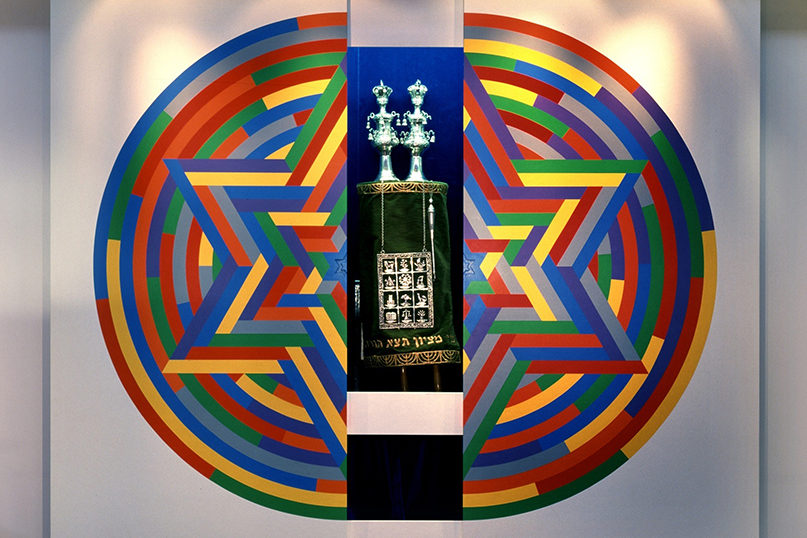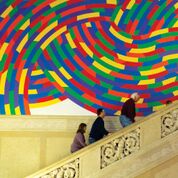
In his new book, author Lary Bloom tells the story of his friend, Sol LeWitt
By Stacey Dresner
CHESTER – “The idea becomes the machine that makes the art.”
Lary Bloom uses that Sol LeWitt quote early on when describing the renowned artist and Connecticut native in his new book, Sol LeWitt: A Life of Ideas.
 Through LeWitt’s many works, including his trademark boldly colorful wall drawings and his stark sculptures, including one at the United States Holocaust Memorial Museum, LeWitt became a noted creator of minimalist and conceptual art beginning in the mid-20th century.
Through LeWitt’s many works, including his trademark boldly colorful wall drawings and his stark sculptures, including one at the United States Holocaust Memorial Museum, LeWitt became a noted creator of minimalist and conceptual art beginning in the mid-20th century.
Born in Hartford to Russian-Jewish immigrants and raised in New Britain, LeWitt was well known in the art world but left a “faint self-portrait,” says Bloom, who was a neighbor and friend of LeWitt’s in the town of Chester. Both Bloom and LeWitt belonged to Beth Shalom Rodfe Zedek, the synagogue that LeWitt designed in 2001 with architect Stephen Lloyd, basing his design on the old wooden synagogues of Eastern Europe that had been destroyed by the Nazis during World War II.
Bloom began to research and write the biography a few months after LeWitt’s death in 2007. Over the 10 years it took to finish the book, Bloom interviewed more than 100 friends, family members and fellow artists. Published by Wesleyan University Press, A Life of Ideas was released on April 2.
The book tells of “Solly’s” boyhood after the death of his father, his time studying art at Syracuse University, and his stint in the U.S. Army fighting in the Korean Conflict. Bloom also shares with readers anecdotes and stories from and about LeWitt’s fellow artists, including his good friend, sculptor Eva Hesse, as well as from critics, and curators of galleries and museums where LeWitt’s art has been displayed.
Lary Bloom is an author, columnist, editor, teacher, playwright and lyricist. His other books include The Writer Within, Letters From Nuremberg (with Christopher J. Dodd), The Test of Our Times (with Tom Ridge), Lary Bloom’s Connecticut Notebook, and The Ignorant Maestro (with Itay Talgam). His columns have appeared in the New York Times, Connecticut Magazine, the Hartford Courant and other publications.
He has taught writing at Yale, Fairfield University, Trinity College and Wesleyan University. His plays include Wild Black Yonder, Worth Avenue and the musical A Woman of a Certain Age.
Bloom will talk about his book on June 2 at Beth Shalom Rodfe Zedek in Chester at 4 p.m.
He recently spoke to the Jewish Ledger about his new book and his relationship with Sol LeWitt.
JEWISH LEDGER (JL): How did you come to meet and become friends with Sol LeWitt?
LARY BLOOM (LB): His was one of the first names you heard when you moved to Chester because you had these two “giants” living in town. I don’t want to dismiss the work of others too – there are many accomplished people in Chester. But there were two that were kind of known far and wide – Sol and Morley [Safer]. They were the town “A” celebrities and both were members of the synagogue. But Morley was out there – his face was on 60 Minutes, and Sol was just the opposite. His face was nowhere.
He had an ability to dodge the photographer’s lens that was well known. His name was bandied about but a lot of people wouldn’t know him if they saw him. On the other hand there were many people who did know him. He was certainly a pleasant fellow; he just wasn’t a smaller talker.
I think one of the things that drew us together was our ridiculous devotion to the Cleveland Indians. For me it was a natural affection because I grew up in Cleveland, but for Sol it wasn’t. It was more of a demonstration very early in life that he didn’t want to be a part of the group. He wanted to be an independent thinker and everybody in New Britain when he was growing up was either a Red Sox or Yankees fan. So that was enough of that.
During my years when I was a friend of his I used to go over to the studio that he built on his property on Pratt St. in Chester and we would just talk. We’d talk not about art, but about politics, about the stuff of life. Like a lot of people, I was drawn to him because of his own quiet optimism about life – that things could be done, that criticism could be ignored and should be ignored. Not that it can’t be helpful, but that get-up-off-the-canvas-and-kick-some-ass [attitude]. Just move forward. Which is a good message for anybody.
JL: Was it difficult to find information about him to write the book since he was so notoriously private?
LB: There is an oddity there. Yes, he was private, but almost everyone I spoke to was eager to help. No one said to me, “He was a private man; I can’t talk about what we did.” And I think one of the reasons was he had been so good to them. As a person who was in a field in which people are typically focused on themselves, he wasn’t. He was equally focused on his peers and helped people, especially women but men too. [Composer] Philip Glass told me about his years as a taxi driver and that the only money he ever made from his musical scores was the money that Sol paid to buy his music. Sol of course couldn’t do anything with it; he wasn’t a musician. But he wanted to support people he knew were very good, like Eva Hesse and others.
So, many people were grateful to Sol and wanted to tell his story and wanted to help me do that.
JL: You mention in the book that his interest in Judaism grew when his daughters were born. Did the two of you talk about religion?
LB: I never addressed that in the book in terms of his level of what you might call his religiosity. I know he identified certainly as a Jewish person and came to services. He came to Wednesday morning minyan with his dog. And of course he designed the building. So I think it was important to him. I couldn’t make a judgment on his beliefs. I do know that he was pleased to be a member of the synagogue…although it was no secret that going to meetings was not a delight to him. He did get something from it.
He put himself on the line for the design of the synagogue. The board had rejected the design of a company in Westport that had designed many synagogues because they felt it was a cookie-cutter, suburban solution to an exurban problem, which was that this was a special place and needed a special design. So, in steps Sol who had been so affected by the designs of the Eastern European wooden synagogues. … He wanted to see if he could design one here and he did, with the help of an actual architect, Stephen Lloyd.

Sol LeWitt’s wraparound wall drawing in the lobby of the Wadsworth Atheneum Museum of Art in Hartford. (Randy Duchaine/Alamy Stock Photo)
JL: What are your thoughts about Sol’s art? Did you get a sense of his philosophy as an artist?
LB: As a writer, I deal in a different way with the perceptions of others who see my work. It is through that lens that I look at Sol. No doubt my appreciation for Sol is affected by what I know is the rule in the artistic world, which is that there is a marketplace and you best follow that marketplace if you want to make a living. The book that you write has to be no longer than 80,000 words, and it has to have this or that. I could see that any artist trying to fit into the marketplace faces the same problem.
But Sol’s view was that you have to do what you have to do. It’s the idea that if you are an artist in a studio and you have canvas, which is what artists did until Sol came along, you don’t say to yourself, “If I put a little more orange in the upper right I’ll get $10,000 more for this painting.” You do what must be done to make the painting work. … You don’t do the work based on what the market demands. As a matter of fact, he said doing what the market demands or doing something over and over just to make money is deadening. It kills the spirit. Investing in learning about what he did was a huge enlightenment for me.
I’ll never forget, in 2000, when his cross-country retrospective came to New York, it was spread over several floors of the Whitney [Museum of American Art]. I remember the fifth floor elevator floor opened and I saw this enormous purple wall and I started to cry… At that point I didn’t really know much [about his work]. Fifteen years later, I was in a gallery in Amsterdam that had one of his wall drawings and I watched as a little girl, who couldn’t have been more than four, came into the room and spread her arms out and her face in this expression of total delight. She is looking at this multi-colored wall with these vertical stripes and she is having the time of her life. And that was exactly what happened to me when I saw the purple wall [at the Whitney].
JL: Do you think one must be an art lover to appreciate this book or will it appeal to all kinds of readers?
LB: It’s for anybody who has ever suffered a disappointment, anybody who is ever suffered rejection for what they’ve done, anybody who feels stifled by their work, anybody who wants some kind of reassurance that the future can be better than the present. And what it takes to succeed in the long run, not in the next 15 minutes. I think that is about everybody. I think that’s who the book is for. [As Sol might say], everybody else, the hell with it…
For more information on Lary Bloom’s June 2 talk at Beth Shalom Rodfe Zedek in Chester call (860) 526-8920 or visit cbsrz.org.







 Southern New England Jewish Ledger
Southern New England Jewish Ledger
















